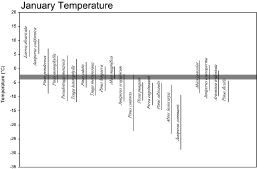
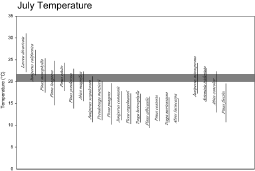
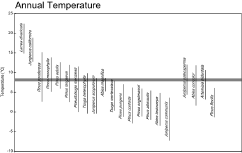
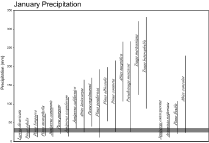
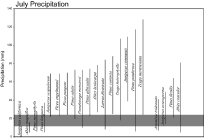
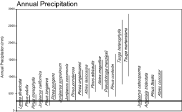

EVALUATION OF CLIMATIC ANOMALIES FOR THE LGM
As discussed above, Spaulding (1985) estimated climatic anomalies for the late Pleistocene based on the present-day southern-most and/or lowest elevational occurrences of key plant species that were recovered from packrat middens in the Yucca Mountain region. Tables 2 and 4 illustrate the differences between Spaulding's and our paleoclimatic reconstructions for the LGM (interpolated to the 5000 ft [1524 m] elevation of the proposed repository). Although our results indicate somewhat warmer and wetter conditions than Spaulding's, the absolute differences between the two approaches are not great for either mean annual temperature (6.5° C versus 7.5° C) nor for mean annual precipitation (246 - 265 mm versus 266 - 321 mm). As discussed in greater detail below, the differences between these estimates are substantially less than the variability observed during the historic period.
 Figure 7. (click to enlarge) |
 Figure 8. (click to enlarge) |
 Figure 9. (click to enlarge) |
 Figure 10. (click to enlarge) |
 Figure 11. (click to enlarge) |
 Figure 12. (click to enlarge) |
Importance of Historical Climatic Baseline Data. Although the absolute differences between our estimates and those of Spaulding (1985) are small, the calculated anomalies for precipitation are large. As shown in Table 4, Spaulding's anomalies for LGM mean annual precipitation (based on Beatly's historic climate data) are 57 to 76 mm, which indicates precipitation at levels 1.3 to 1.4 times historic values. In contrast, our LGM mean annual precipitation anomalies (based on our historic climate normals) are 141 to 196 mm, which implies LGM precipitation at levels 2.1 to 2.6 times historic values. These comparisons point out the importance of the modern climatic baseline data in the assessment of the differences between present-day and late Pleistocene climates. As discussed above, our baseline is based on the climate "normals" for the period 1951 to 1980, with the great majority of our data obtained from U.S. Weather Service calculations of these "normal" values. Thus these data provide a baseline that is continental in scale, that is based on three decades of records, and that conforms to the U.S. Weather Service standards. However, this data set does not provide detailed coverage in proximity to Yucca Mountain. In contrast, Spaulding (1985) employed a modern baseline derived from data on the Nevada Test Site collected by Beatly (1975, 1976) for the period 1963 to 1972. This dataset provides more local data, but was collected with non-standard methods (which may over-estimate precipitation) for only a decade.
| Estimated Values | Reconstructed Values | Anomalies based on Spaulding Modern Values | Anomalies based on This Report Modern Values | ||||||||
|---|---|---|---|---|---|---|---|---|---|---|---|
| MODERN | LGM Minumum |
LGM Maximum |
LGM Minumum |
LGM Maximum |
LGM Minumum |
LGM Maximum |
|||||
| Mean Annual Temperature | °C | °C | °C | °C | °C | °C | °C | ||||
| Spaulding | 13.5 | 6.5 | 7.5 | 7.0 | 6.0 | 6.9 | 5.9 | ||||
| This Report | 13.4 | 7.9 | 8.5 | 5.6 | 5 | 5.5 | 4.9 | ||||
| Mean Annual Precipitation | mm | mm | mm | mm | mm | mm | mm | ||||
| Spaulding | 189 | 246 | 265 | 57 | 76 | 121 | 140 | ||||
| This Report | 125 | 266 | 321 | 77 | 132 | 141 | 196 | ||||
| Multiplier for Annual Precipitation | Mod. X | Mod. X | Mod. X | Mod. X | |||||||
| Spaulding | 1.3 | 1.4 | 2.0 | 2.1 | |||||||
| This Report | 2.1 | 2.6 | 1.4 | 1.7 | |||||||
Mod. X = Modern mean annual precipitation multiplied by this number
For the analyses in this report we interpolated the modern climate estimates to the elevation of the proposed repository at 5000 ft (1524 m). Although the two data sets have very similar mean annual temperature estimates for this elevation (Tables 2 and 4), Spaulding's estimates of modern mean annual precipitation are significantly higher than ours. The National Oceanic and Atmospheric Administration (NOAA) provides historic climatic data by divisions within each state (NCDC, 1994; Karl and others, 1986), and (unfortunately) Yucca Mountain is located on the boundary between Nevada Divisions 3 and 4. These data indicate that annual temperature varied relatively little between 1950 and 1972 (the combined period of the Spaulding and our baseline data; Figure 13). However, precipitation increased almost monotonically over this interval, with the result that our baseline (1951 to 1980) for annual precipitation falls near the long-term historic mean, whereas that employed by Spaulding (1963 to 1972) covers a much wetter period (and, in addition, Beatly's measurements may overestimate precipitation, Figure 14). The differences in precipitation estimates in the modern baselines employed by Spaulding (1985) and in this report greatly influence the calculated anomalies for the LGM (Table 4). In fact, the differences in these anomalies is influenced more by the differences in the modern baseline data than by differences in the estimation of late Pleistocene climates (Figure 15).
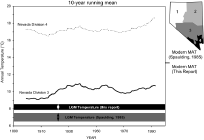 Figure 13. (click to enlarge) |
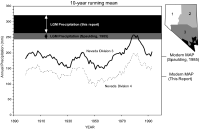 Figure 14. (click to enlarge) |
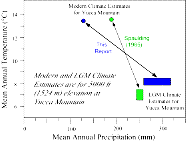 Figure 15. (click to enlarge) |
Comparison of Reconstructed LGM Climates With Historical Climatic Variations. As discussed above, Yucca Mountain is located on the boundary between NOAA Nevada Climatic Divisions 3 and 4. Over the past century, historic variations in precipitation in both of these divisions have reached levels (on an annual basis) as high as those reconstructed for the LGM (Figure 16). However,
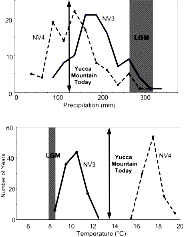 Figure 16. (click to enlarge) |
Although individual years in the historic period had conditions that approached those reconstructed for the LGM, on a decadal basis the climate of Nevada Division 3 has remained warmer and (generally) drier than that of the LGM (Figure 18). The range of inter-decadal variability over the past century has been ~2° C and ~97 mm in Nevada Divisions 3 and 4, exceeding the differences in LGM estimates between Spaulding (1985) and this report.
Potential influences of changes in atmospheric chemistry on plant communities. Atmospheric carbon dioxide concentrations during the late Pleistocene were greatly reduced relative to pre-industrial Holocene levels, and during the LGM they were as low as ~190 ppmv (versus ~280 ppmv during the Holocene, Barnola and others, 1987). In addition to its effects on global climates, this change in atmospheric chemistry may have had influences on the physiology of plants, their elevational distributions, and the sensitivity of plant species and communities to climatic variations (Ehleringer and others, 1997). Woodward (1987) demonstrated that stomatal density decreased during the last 200 years in a variety of species due to the increased availability of carbon dioxide in the atmosphere following the industrial revolution. Van de Water and others (1994) demonstrated that fossil needles of Pinus flexilis in the Southwestern United States had 17% greater stomatal density during the LGM than at 12,000 years ago (by which time atmospheric carbon dioxide had increased 30% over LGM levels). By their calculations, water-use efficiency for this species would have been ~15% lower at the LGM than at 12 ka, assuming constant temperature and humidity.
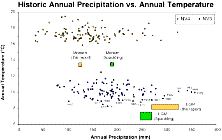 Figure 17. (click to enlarge) |
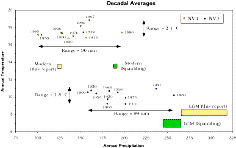 Figure 18. (click to enlarge) |
Ecophysiological modeling by Jolly and Haxeltine (1997) suggests that much of the lowering of upper treelines in East Africa during the LGM could be directly caused by the lower concentrations of atmospheric carbon dioxide. They also found that some vegetational assemblages increased their climatic tolerances under lower levels of carbon dioxide. At this point we have no way to assess how well this concept applies to the Yucca Mountain region, but the stability through time of the limber pine/Utah juniper woodland (as other indicators of climate changed through time) could conceivably be due to changes in climatic sensitivity of vegetation related to changes in atmospheric chemistry. Using the African model, it is possible that the apparent changes in lapse rates for temperature could be due (at least in part) to an expanded range of climatic tolerance of woodland vegetation (relative to today). In any case, the increased stomatal density should have decreased water-use efficiency for most plants during the LGM, and hence they would require greater-than-modern levels of precipitation to sustain themselves. Hence, our estimates of late Pleistocene precipitation may be too low, especially for the LGM.
1) For 5000 ft (1524 m) at the Yucca Mountain repository we estimate that mean annual temperature (MAT) and precipitation (MAP) differed from our modern baseline data as follows:
35 to 30 ka: MAT = ~4° C colder than today, MAP = 1.5X modern levels;2) The selection of historic baseline data has strong influence on the perceived differences between Pleistocene and "modern" climates. The baseline data used by Spaulding (1985) was significantly wetter than either the baseline employed in this report or the long-term historic mean. Consequently, Spaulding's estimates of the difference between late Pleistocene and "modern" precipitation levels is much lower than ours.27 to 23 ka: MAT = ~5° C colder than today, MAP = 2.2X modern levels;
20.5 to 18 ka: MAT = ~8° C colder than today, MAP = 2.4X modern levels;
14 to 11.5 ka: MAT = ~5.5° C colder than today, MAP = 2.6X modern levels
3) It is difficult to assess the potential effects of decreased atmospheric carbon dioxide concentrations during the late Pleistocene on the physiology of various plant species. However, it is plausible that nearly all species required higher levels of moisture than they do under higher concentrations of carbon dioxide during the 20th century. Consequently, our estimates of late Pleistocene precipitation levels may be too low.
4) During the early part of this century there were several years when the climate of the region adjoining Yucca Mountain on the north approached the annual temperature and moisture conditions reconstructed for the LGM at Yucca Mountain. Inter-decadal variability in the historic climate record is greater than the differences in the LGM reconstructions of Spaulding (1985) and this report.
|
NEXT: References |
| AccessibilityFOIAPrivacyPolicies and Notices | |
| |
|